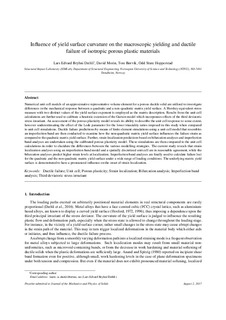| dc.contributor.author | Dæhli, Lars Edvard | |
| dc.contributor.author | Morin, David | |
| dc.contributor.author | Børvik, Tore | |
| dc.contributor.author | Hopperstad, Odd Sture | |
| dc.date.accessioned | 2017-10-16T13:27:09Z | |
| dc.date.available | 2017-10-16T13:27:09Z | |
| dc.date.created | 2017-09-18T14:12:09Z | |
| dc.date.issued | 2017 | |
| dc.identifier.citation | Journal of the mechanics and physics of solids. 2017, 107 253-283. | nb_NO |
| dc.identifier.issn | 0022-5096 | |
| dc.identifier.uri | http://hdl.handle.net/11250/2460353 | |
| dc.description.abstract | Numerical unit cell models of an approximative representative volume element for a porous ductile solid are utilized to investigate differences in the mechanical response between a quadratic and a non-quadratic matrix yield surface. A Hershey equivalent stress measure with two distinct values of the yield surface exponent is employed as the matrix description. Results from the unit cell calculations are further used to calibrate a heuristic extension of the Gurson model which incorporates effects of the third deviatoric stress invariant. An assessment of the porous plasticity model reveals its ability to describe the unit cell response to some extent, however underestimating the effect of the Lode parameter for the lower triaxiality ratios imposed in this study when compared to unit cell simulations. Ductile failure predictions by means of finite element simulations using a unit cell model that resembles an imperfection band are then conducted to examine how the non-quadratic matrix yield surface influences the failure strain as compared to the quadratic matrix yield surface. Further, strain localization predictions based on bifurcation analyses and imperfection band analyses are undertaken using the calibrated porous plasticity model. These simulations are then compared to the unit cell calculations in order to elucidate the differences between the various modelling strategies. The current study reveals that strain localization analyses using an imperfection band model and a spatially discretized unit cell are in reasonable agreement, while the bifurcation analyses predict higher strain levels at localization. Imperfection band analyses are finally used to calculate failure loci for the quadratic and the non-quadratic matrix yield surface under a wide range of loading conditions. The underlying matrix yield surface is demonstrated to have a pronounced influence on the onset of strain localization. | nb_NO |
| dc.language.iso | eng | nb_NO |
| dc.publisher | Elsevier | nb_NO |
| dc.rights | Attribution-NonCommercial-NoDerivatives 4.0 Internasjonal | * |
| dc.rights.uri | http://creativecommons.org/licenses/by-nc-nd/4.0/deed.no | * |
| dc.title | Influence of yield surface curvature on the macroscopic yielding and ductile failure of isotropic porous plastic materials | nb_NO |
| dc.type | Journal article | nb_NO |
| dc.type | Peer reviewed | nb_NO |
| dc.description.version | acceptedVersion | nb_NO |
| dc.source.pagenumber | 253-283 | nb_NO |
| dc.source.volume | 107 | nb_NO |
| dc.source.journal | Journal of the mechanics and physics of solids | nb_NO |
| dc.identifier.doi | 10.1016/j.jmps.2017.07.009 | |
| dc.identifier.cristin | 1494866 | |
| dc.description.localcode | © 2017. This is the authors’ accepted and refereed manuscript to the article. LOCKED until 10.7.2019 due to copyright restrictions. This manuscript version is made available under the CC-BY-NC-ND 4.0 license http://creativecommons.org/licenses/by-nc-nd/4.0/ | nb_NO |
| cristin.unitcode | 194,64,45,0 | |
| cristin.unitname | Institutt for konstruksjonsteknikk | |
| cristin.ispublished | true | |
| cristin.fulltext | postprint | |
| cristin.qualitycode | 2 | |

